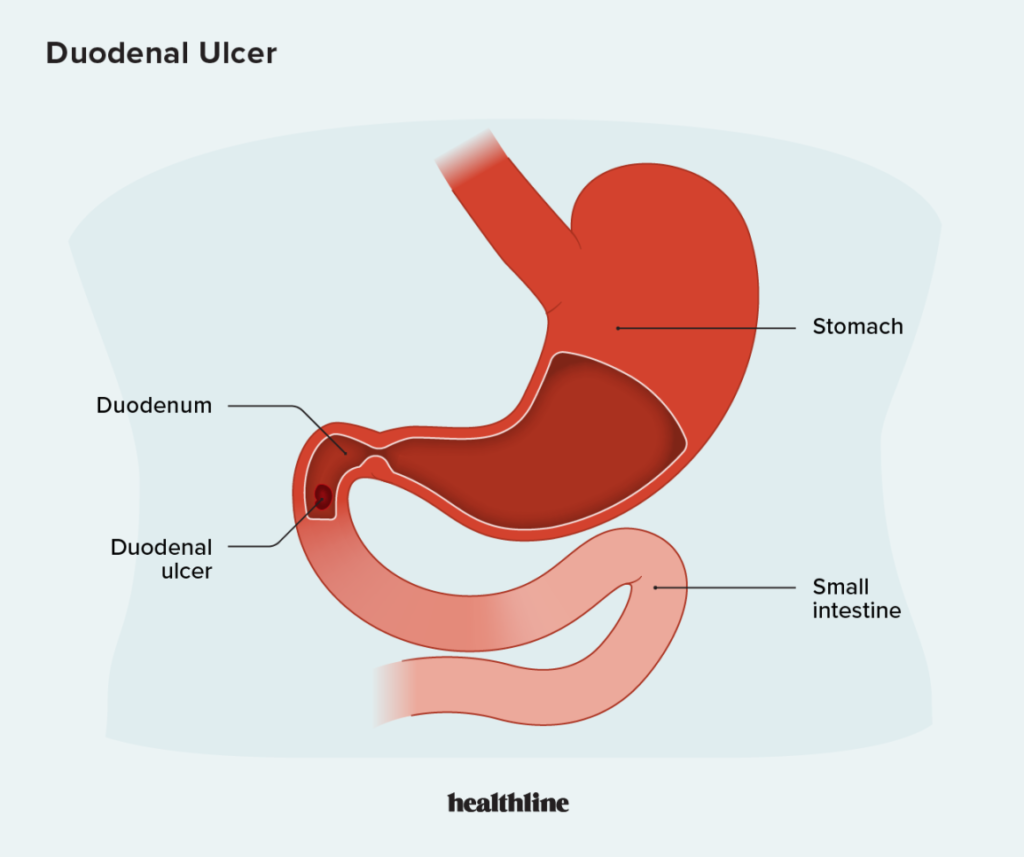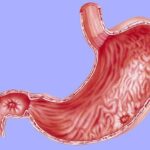A duodenal ulcer is a type of peptic ulcer that manifests as an open sore on the inner lining of the duodenum, the initial segment of the small intestine. This condition arises when the protective mucosal barrier is compromised, allowing stomach acid to erode the intestinal lining. Understanding the etiology, clinical presentation, diagnostic approaches, and management options is crucial for effective treatment and prevention.

Etiology and Risk Factors
The predominant causes of duodenal ulcers include infection with Helicobacter pylori (H. pylori) bacteria and prolonged use of nonsteroidal anti-inflammatory drugs (NSAIDs).
- Helicobacter pylori Infection: This gram-negative bacterium colonizes the stomach lining, leading to chronic inflammation and increased gastric acid secretion, which can damage the duodenal mucosa. Transmission is primarily oral-oral or fecal-oral, often occurring during childhood.
- NSAID Usage: Chronic consumption of NSAIDs, such as ibuprofen and aspirin, can impair the stomach’s ability to produce protective mucus by inhibiting cyclooxygenase enzymes, thereby increasing susceptibility to ulcer formation.
Additional risk factors encompass smoking, excessive alcohol consumption, and severe physiological stress, which may exacerbate mucosal damage and impede healing processes.
Clinical Manifestations
Duodenal ulcers may present with a spectrum of symptoms, ranging from mild discomfort to severe pain. Common clinical features include:
- Epigastric Pain: A burning or gnawing sensation in the upper abdomen, typically occurring 2-3 hours postprandially or during the night, and often relieved by food intake or antacids.
- Bloating and Abdominal Fullness: A sensation of fullness or bloating, particularly after meals.
- Nausea and Vomiting: Episodes of nausea, occasionally accompanied by vomiting.
- Weight Changes: Unintentional weight loss or, less commonly, weight gain due to altered eating habits aimed at pain relief.
In some cases, duodenal ulcers may be asymptomatic and only identified upon the occurrence of complications.
Diagnostic Evaluation
Accurate diagnosis involves a combination of clinical assessment and investigative procedures:
- Endoscopy (Esophagogastroduodenoscopy – EGD): Direct visualization of the duodenal mucosa to identify ulcers and obtain biopsy samples for H. pylori testing.
- Non-Invasive Testing for H. pylori: Methods include urea breath tests, stool antigen tests, and serological assays to detect active infection.
- Laboratory Assessments: Complete blood count to check for anemia, and stool tests for occult blood, indicating gastrointestinal bleeding.
Management Strategies
Treatment aims to eradicate H. pylori infection, reduce gastric acidity, and promote mucosal healing:
- Antibiotic Therapy: A combination regimen, often referred to as triple therapy, includes two antibiotics (such as amoxicillin and clarithromycin) alongside a proton pump inhibitor (PPI) to eliminate H. pylori.
- Proton Pump Inhibitors (PPIs): Medications like omeprazole or esomeprazole reduce gastric acid production, facilitating ulcer healing and symptom relief.
- Discontinuation of NSAIDs: Ceasing NSAID use when possible, or substituting with alternative analgesics, to prevent further mucosal damage.
- Lifestyle Modifications: Recommendations include smoking cessation, limiting alcohol intake, and dietary adjustments to avoid foods that may irritate the stomach lining.
Potential Complications
Without appropriate treatment, duodenal ulcers can lead to serious health issues:
- Bleeding: Erosion into blood vessels may cause gastrointestinal hemorrhage, presenting as hematemesis or melena.
- Perforation: A full-thickness ulcer can create a perforation in the duodenal wall, leading to peritonitis, a medical emergency.
- Gastric Outlet Obstruction: Chronic inflammation and scarring can result in narrowing of the duodenal lumen, causing obstructive symptoms like persistent vomiting and abdominal distension.
Preventive Measures
Preventing duodenal ulcers involves addressing modifiable risk factors:
- H. pylori Eradication: Completing prescribed antibiotic regimens to eliminate infection and reduce recurrence risk.
- Judicious NSAID Use: Utilizing the lowest effective dose for the shortest duration, and considering protective agents like PPIs when long-term NSAID therapy is necessary.
- Lifestyle Adjustments: Adopting a balanced diet, engaging in regular physical activity, and avoiding tobacco and excessive alcohol consumption to enhance overall gastrointestinal health.

